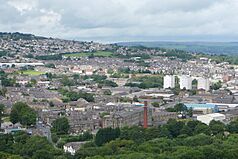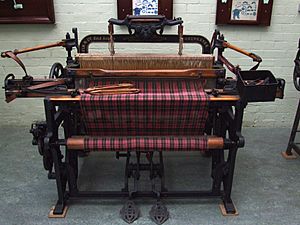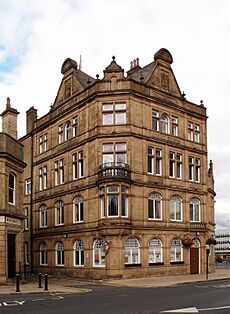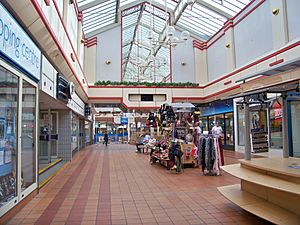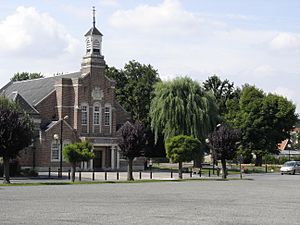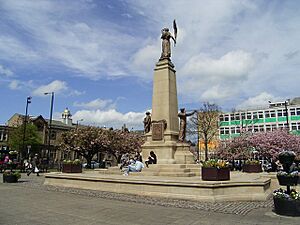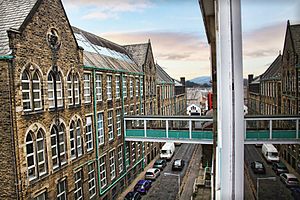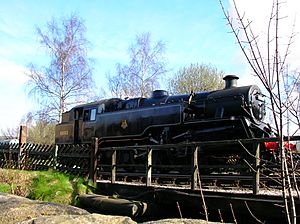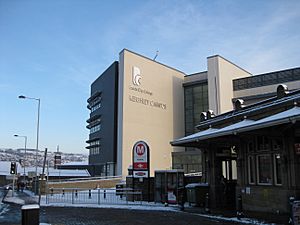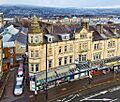Keighley facts for kids
Quick facts for kids Keighley |
|
|---|---|
|
Clockwise from top : View over Keighley, Dalton Mills, Markazi Jamia Mosque, North street, Town Hall |
|
| Population | 57,345 (2021 Census) |
| OS grid reference | SE058412 |
| Civil parish |
|
| Metropolitan borough | |
| Metropolitan county | |
| Region | |
| Country | England |
| Sovereign state | United Kingdom |
| Post town | KEIGHLEY |
| Postcode district | BD20, BD21, BD22 |
| Dialling code | 01535 01274 |
| Police | West Yorkshire |
| Fire | West Yorkshire |
| Ambulance | Yorkshire |
| EU Parliament | Yorkshire and the Humber |
| UK Parliament |
|
Keighley (![]() i/ˈkiːθli/ KEETH-lee) is a busy market town in West Yorkshire, England. It is the second largest town in the City of Bradford area, right after Bradford itself.
i/ˈkiːθli/ KEETH-lee) is a busy market town in West Yorkshire, England. It is the second largest town in the City of Bradford area, right after Bradford itself.
Keighley is located about 8 miles (13 km) north-west of Bradford. It's also 4 miles (6.5 km) north-west of Bingley and 8 miles (13 km) south-east of Skipton. The town is run by the Keighley Town Council and the Bradford City Council. Keighley is in West Yorkshire, close to the borders of North Yorkshire and Lancashire. It sits between the Airedale valley and the Keighley Moors. In 2011, Keighley had a population of 56,348 people.
Contents
- History of Keighley
- How Keighley is Governed
- Geography of Keighley
- Population of Keighley
- Keighley's Economy
- Community and Culture
- Media and Twinning
- Famous Landmarks and Attractions
- Education in Keighley
- Religions in Keighley
- Sports in Keighley
- Keighley in Films and TV
- Famous People from Keighley
- Freedom of the Town
- Images for kids
- See also
History of Keighley
The name Keighley has changed its spelling many times over the years. It is thought to mean "Cyhha's farm or clearing." The town was first mentioned in the Domesday Book as "Cichhelai." This was a big survey of England ordered by William the Conqueror in 1085.
In 1305, a knight named Henry de Keighley was given permission by King Edward I to hold a market in Keighley. This was an important step for the town to grow. Records from 1379 show that 109 people lived in Keighley at that time.
In the 1700s, Keighley became a hub for important roads called "turnpikes." These were roads where people paid a fee to use them. This helped the town connect with other places like Skipton, Bradford, and Halifax.
Keighley has a long history of making textiles, especially wool and cotton fabrics. Many large factories in the town also made machines for the textile industry. One famous company, Dean, Smith & Grace, made special machines called lathes until 2008.
In 1801, the population of Keighley was 5,745 people. The town officially became a municipal borough (a self-governing town) in 1882. Later, in 1974, Keighley became part of the larger City of Bradford Metropolitan District. This change made some local people unhappy, as they felt Bradford was taking over. Because of this, Keighley got its own town council again in 2002. This council has 30 members who choose a mayor each year.
Keighley also has local groups that study its history and family trees. These are the Keighley and District Local History Society and the Keighley and District Family History Society.
How Keighley is Governed
Local Government
Keighley is part of the City of Bradford Metropolitan District. This means that the Bradford City Council helps run the town. However, Keighley also has its own town council. This council was brought back in 2002.
The Keighley Town Council has 30 members. They work to improve the town and represent the people who live here. Every year, these members choose a mayor from among themselves.
National Representation
Keighley is represented in the UK Parliament by a Member of Parliament (MP). This MP speaks for Keighley in the House of Commons in London. Currently, the MP for Keighley is Robbie Moore, from the Conservative Party. He was elected in 2019.
Geography of Keighley
Keighley is located where two rivers meet: the Worth and the Aire. This area is known as Airedale, and it's part of the South Pennines hills. The town stretches up the hills to areas like Black Hill in the west. To the east, it reaches neighbourhoods like Long Lee and Thwaites Brow.
The River Aire flows through the north-eastern part of Keighley. It runs close to the Leeds and Liverpool Canal. The River Worth joins the Aire in an area called Stockbridge. The Worth River used to have many factories along its banks. These factories were important when Keighley was a big textile centre.
Some parts of Keighley can flood, and the town was badly affected by floods in 2000. Since then, a lot of money has been spent to build stronger flood defences.
Around Keighley, there are several nearby villages. These include Oakworth, Cross Roads, Haworth, Stanbury, and Oxenhope. To the north, you'll find Silsden and Steeton. While these are often seen as separate, they are part of the wider Keighley area.
To the north-east of Keighley is Rombald's Moor. This moor has many ancient signs from the Stone Age and Bronze Age, like cup and ring marks. As the moor slopes down towards the town of Ilkley, it becomes the more famous Ilkley Moor.
|
Population of Keighley
The population of Keighley has changed a lot over the years. Here's a look at how many people have lived in the area:
| Year | 1801 | 1811 | 1821 | 1831 | 1841 | 1851 | 1861 | 1871 | 1881 | 1891 |
|---|---|---|---|---|---|---|---|---|---|---|
| Population | 5,745 | 6,864 | 9,223 | 11,176 | 13,413 | 18,259 | 18,819 | 24,704 | 30,395 | 36,176 |
| Source: Vision of Britain – Keighley AP/CP: Total Population. | ||||||||||
| Year | 1901 | 1911 | 1921 | 1931 | 1939 † | 1951 | 1961 | 1971 | 2011 |
|---|---|---|---|---|---|---|---|---|---|
| Population | 41,564 | 43,487 | 41,921 | 40,441 | 56,631 | 56,944 | 55,845 | 55,325 | 56,348 |
| Source: Vision of Britain – Keighley MB: Total Population. | |||||||||
† The 1939 population is an estimate. The 1941 census did not happen because of World War II.
Keighley's Economy
Historically, Keighley's main industries were textiles, especially processing wool and cotton. Many large factories also made machines for the textile industry. One company, Dean, Smith & Grace, made special precision lathes (a type of machine tool) until 2008.
Keighley is also home to Timothy Taylor Brewery. This famous brewery makes award-winning ales like Landlord and Boltmaker. They also own many pubs in the area.
Community and Culture
Much of Keighley's town centre is now for pedestrians only, meaning no cars. The town has a Market Hall, where you can find many different goods. There are also several large supermarkets and smaller shops around town.
The Airedale shopping centre is a big indoor shopping mall. It has many well-known high street shops. Inside, there used to be a 12-foot-tall statue of a giant named Rombald. Local legend says Rombald threw a giant rock at his enemies. This rock is believed to be the "calf" of the "cow and calf" rock formation on Ilkley Moor.
Keighley has one cinema, The Picture House, which opened in 1913. It's one of the oldest cinemas in Britain.
The town has a lively local music scene. Many local bands play here. Famous British rock bands like Skeletal Family and Terrorvision also started in Keighley.
Media and Twinning
Local Media
For local news and TV shows, people in Keighley watch BBC Yorkshire and ITV Yorkshire. There are also several local radio stations, including BBC Radio Leeds and Heart Yorkshire. Local newspapers are the Keighley News and Telegraph & Argus.
Town Twinning
Keighley has a special place in history for town twinning. It was the first town in the world to have a recorded twinning agreement. This happened in 1920 with Poix-du-Nord, France. Even earlier, in 1905, Keighley had a "sister city" arrangement with two towns near Paris, France: Suresnes and Puteaux.
Today, Keighley is twinned with:
- Poix-du-Nord, France
- Myrtle Beach, USA
- Manzini, Eswatini
Famous Landmarks and Attractions
Architecture and Buildings
Keighley has many beautiful Victorian buildings. The local stone, called millstone grit, gives them a unique look.
Some grand old houses include East Riddlesden Hall, Cliffe Castle Museum, and Whinburn Mansion. There are also large townhouses along Skipton Road.
Keighley's central library was the first Carnegie library in England. It opened in 1904 with money from Andrew Carnegie, a famous businessman. The library was updated in 2007. Many of the town's old mill buildings are still standing.
The town centre also has modern buildings, like Leeds City College. You can also see Victorian commercial buildings, such as the long Cavendish Street with its ornamental canopy. There's a modern bus station that opened in 2002.
Places to Visit
On the edge of town is Cliffe Hall, also known as Cliffe Castle. It is now the Keighley Museum.
The Keighley and Worth Valley railway is a special heritage steam railway. It connects Keighley with Haworth, Oakworth, and Oxenhope, which are part of the famous Brontë Country. At Ingrow, you can visit the Museum of Rail Travel.
Top Withens and the Brontë Waterfall are popular walking spots near Haworth. East Riddlesden Hall is located in Riddlesden. You can also visit the Keighley Police Museum in the Keighley Civic Centre. It has old police items, including a Victorian horse-drawn police van.
Education in Keighley
Keighley has several high schools, including Carlton Keighley, Beckfoot Oakbank, Parkside School, and the Holy Family Catholic School.
Keighley College is located near Keighley railway station. In 2010, the college opened a new £30 million campus. The college has an Industrial Centre of Excellence. It also has a special Star Centre facility. This centre encourages young people to study STEM subjects (Science, Technology, Engineering, and Mathematics). It features a mock mission control centre, a planetarium, and a simulated rocky planet surface.
Religions in Keighley
Keighley has a main parish church called Keighley Shared Church. It is home to many different Christian groups. These include Anglicans, Methodists, United Reformed, Mormons, Quakers, Salvation Army, and Jehovah's Witnesses.
Keighley also has a significant Roman Catholic community. This community grew in the mid-1800s when Irish immigrants came to work in the textile factories. Keighley has two Roman Catholic churches and four Roman Catholic schools.
The first spiritualist church in Britain was founded in Keighley in 1853. It was started by David Richmond.
Muslims are the second largest religious group in Keighley. In 2011, there were over 12,400 Muslims in the town. Many came to Britain in the 1960s from Pakistan and Bangladesh. As of 2013, Keighley had eight mosques. These include the Markazi Jamia Masjid (Central Community Mosque) and the Bait al-Aman Ahmadiyya Mosque.
There is also a Buddhist centre in the town centre. The Keighley Kadampa Buddhist Centre offers classes for people interested in the Buddhist faith.
Sports in Keighley
Keighley Cougars is a semi-professional rugby league team. They play at Cougar Park. The Keighley RUFC rugby union team plays at Rose Cottage in Utley.
Keighley Central F.C. was a football club that won a league title in 1964.
In 2014, the famous Tour de France cycling race passed through Keighley. It was part of Stage 2 of the race.
Keighley in Films and TV
Film Appearances
Keighley was the setting for the film Blow Dry. This movie is about a hair championship held in the town. Although set in Keighley, the film was shot in several different places.
Most of the 2004 film Yasmin was filmed in Keighley. It tells the story of a British Muslim woman after the September 11 attacks.
The Keighley and Worth Valley Railway (KWVR) has been used in many films. These include The Railway Children, Yanks, and parts of the Pink Floyd musical The Wall. An episode of the TV show The Last of the Summer Wine was also filmed there. The TV show A Touch of Frost also filmed scenes near the railway line.
The film Between Two Women (2000) was filmed a lot in and around Keighley's mills and railway. The film The Jealous God (2005) also featured Keighley railway station.
The film God's Own Country was filmed in Laycock and at Keighley bus station.
Television Appearances
A large part of the 2004 BBC television drama North and South was filmed in Keighley. Dalton Mills was one of the main locations for the show.
The Keighley and Worth Valley Railway depot was also seen in an episode of All Creatures Great and Small in 2023.
Famous People from Keighley
Many notable people have connections to Keighley:
- Simon Beaufoy (born 1967) – An award-winning screenwriter who was born in Keighley.
- Steve Binns (born 1960) – A long-distance runner who competed in the 1988 Olympic Games.
- Asa Briggs (1921–2016) – A famous historian and academic.
- Brontë Sisters – Lived in the nearby village of Haworth.
- Harry Brook (born 1999) – A cricketer for Yorkshire and England.
- Alastair Campbell (born 1957) – A former advisor to the Labour party.
- Kiki Dee (born 1947) – A singer-songwriter.
- Denis Healey (1917–2015) – A well-known Labour politician.
- Sir Isaac Holden, 1st Baronet (1807–1897) – An inventor and manufacturer.
- Paul Hudson (born 1971) – A local television weather forecaster.
- Dougie Lampkin (born 1976) – A motorcycle trials rider from nearby Silsden.
- Peter Mayhew (1944–2019) – The British actor who played Chewbacca in the Star Wars films, lived in Keighley for many years.
- Sir Tom Moore (1920–2021) – A former British Military Officer who became famous for raising money for NHS charities during the COVID-19 pandemic.
- Philip Snowden (1864–1937) – The first Labour Chancellor of the Exchequer.
- Mollie Sugden (1922–2009) – A well-known television comedy actress.
- Ricky Wilson (born 1978) – A musician from the band Kaiser Chiefs.
- Margaret Wintringham (1879–1955) – The second woman to take a seat in the House of Commons.
Freedom of the Town
Some special people and military groups have been given the "Freedom of the Town" of Keighley. This is a great honour.
Individuals Honoured
- Benjamin Septimus Brigg (First Mayor)
- Sir John Brigg
- Andrew Carnegie (Famous businessman and philanthropist)
- John Tiplady Carrodus: 5 February 1895.
- Sir Isaac Holden, 1st Baronet
- Captain Sir Thomas Moore: 16 April 2020.
- Sir Swire Smith: March 1918.
- Lord Snowdon of Ickornshaw
Military Units Honoured
- The Yorkshire Regiment: 2011.
Images for kids
-
Buildings formerly occupied by Keighley College, now part of Leeds City College.
See also
 In Spanish: Keighley para niños
In Spanish: Keighley para niños


